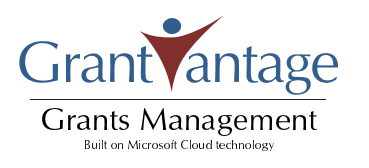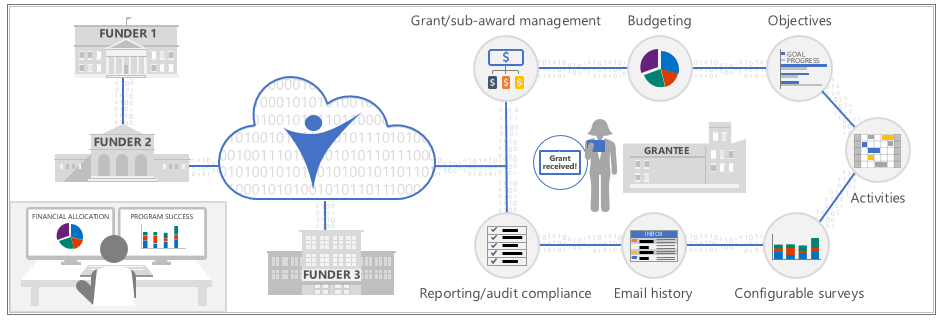Is your grants management approach optimized?
As the use of cloud and digital technologies grow in the grants space, they are transforming how funders, intermediaries and their grantees interact. Over the coming months, we’ll be blogging about some of the groundbreaking ways that Microsoft and partner technologies are supporting that transformation. Today’s blog post features GrantVantage®, a Microsoft partner helping grant management professionals use cloud technology to dramatically improve the efficacy and efficiency of the grant process.
Grants are one of the primary ways that large governments – and independent funders – invest in the lives of citizens. In 2016, the US Federal Government disbursed more than $650B in grant awards; 84 percent went directly to state and local governments in the form mandatory or discretionary grants. The EU also makes large investments in communities; in 2015, project and program funding rang in at about €154B.1 In Australia, the government provides support to the nonprofit sector to the tune of more than $25.5B annually.2 Grants are critical to citizen services in many different areas, including transportation, education, research and social services.
While demand for grant funding is high, budgets are limited. Grant funders must ensure their investments are being used as effectively as possible, while grant recipients must provide quantitative proof of their efficacy to win funding. The stakes are high to ensure grant funders are making well-informed funding decisions.
Grants management is too often complex, tedious and incredibly inefficient
Today, manual reporting processes consume the time and effort of many grant recipients and funders. When funders have different reporting requirements, as many do, the result is redundant reporting and endless paperwork. In a survey of US grant recipients, 75 percent responded3 that the complexity and time required for applying and reporting on contracts was a problem. Manual reporting keeps recipients from doing what they are meant to do: strengthen communities.
The headache of manual reporting is magnified by decentralized data storage. When information is scattered across employees’ hard drives and inboxes, it takes a massive effort to unite data and gain an accurate understanding of spending and efficacy. Furthermore, decentralized data is at a much higher risk of being lost in the event of a computer malfunction or employee turnover. With 69 percent of organizations experiencing data loss4 due to employee turnover, it is especially important that grant organizations manage their data carefully. Data loss puts grant recipients at risk of falling out of reporting compliance and losing time trying to recover lost information.
Poor grant management systems also affect funders. A lack of budget visibility impacts grant funders’ abilities to effectively disburse funds to grantees. At the end of FY15, the US Government Accountability Office found almost $1B5 in undisbursed funding remaining in grant accounts which had expired. When funders lack in-depth insight into the efficacy of projects being funded, it opens the door for wasteful spending. A report6 by the US Office of the Inspector General found that $3B of grant money used by FEMA in 2015 was deemed “questionable,” and may have been wasted.
Even the most well-intended regulations increase reporting burdens
Worldwide, policymakers are implementing new regulations to standardize the grant process, particularly around linking spending to objective performance.
In the US, the DATA Act increases financial reporting requirements to improve public access to information on federal expenditures, providing transparency on what tax money is funding. In the European Union, the Regulation of the European Parliament and of the Council in 2016 works to standardize financial reporting rules. These regulations are intended to improve and standardize grant records and processes, and to ensure grant funds are put to good use. However, with each new regulation comes new reporting requirements, and many grant recipients do not have the resources to comply with these new regulations.
Outdated technology, slow processes and evolving standards – that’s what the typical grantee/grant manager is dealing with today. While the recent regulations serve as a safeguard for the citizens’ investments, grantees and grant managers are now faced with requirements they cannot meet and efficacy standards they cannot prove. Without a solution that helps them to quickly adapt to these requirements, grantees will likely find themselves without funding.
Introducing Grants Management
 Many of these challenges can be addressed with a modern technology solution. The GrantVantage® Grants Management solution, built on Microsoft Cloud technology, offers revolutionary insight into all grant activity. It provides funders, recipients, sub-recipients and intermediaries with visibility into the same detailed insights. With the ability to provide department, office or program-level reporting, grant recipients and intermediaries are empowered to seamlessly update their progress and easily report to their funders.
Many of these challenges can be addressed with a modern technology solution. The GrantVantage® Grants Management solution, built on Microsoft Cloud technology, offers revolutionary insight into all grant activity. It provides funders, recipients, sub-recipients and intermediaries with visibility into the same detailed insights. With the ability to provide department, office or program-level reporting, grant recipients and intermediaries are empowered to seamlessly update their progress and easily report to their funders.
GrantVantage® makes it easy to track and manage both budget and program activities. With powerful budget tracking tools, grant recipients gain greater visibility into their own spending while meeting the demands of heightened budget reporting requirements. Grant professionals are empowered to manage and track sub-recipient management at multiple levels and provide funder-specific reporting. Moreover, GrantVantage® takes organizations beyond financial reporting, enabling users to effortlessly manage objectives, performance measures, data collection, budgets and compliance reporting. Enhanced performance visualization capabilities enable all parties to showcase program impact by presenting data-driven program insights in a compelling way.
GrantVantage® can help ease your organization’s challenges so you can focus on your broader mission and objectives, instead of on tedious administrative activities. Learn more and try the solution on Microsoft AppSource today.
1http://ec.europa.eu/budget/financialreport/2015/foreword/index_en.html
2https://www.cpaaustralia.com.au/~/media/corporate/allfiles/document/professional-resources/notforprofit/grants-in-australia.pdf?la=en
3http://www.urban.org/sites/default/files/publication/24231/412962-Nonprofit-Government-Contracts-and-Grants-Findings-from-the-National-Survey.PDF
4https://betanews.com/2017/01/03/departing-employee-data-risk
5https://betanews.com/2017/01/03/departing-employee-data-risk
6https://www.oig.dhs.gov/assets/pr/2016/oigpr-120716.pdf





